Reliance on Plastics and Insufficient Safety Measures Put Our Future at Risk
What was a quiet evening on February 3rd, 2023, suddenly became a disaster for the residents of East Palestine, Ohio. At 8:54 PM, a Norfolk Southern train carrying 1.6 million pounds (over 725,000 kg) of toxic chemicals derailed, spreading vinyl chloride, isobutylene, and butyl acrylate into the soil, air, and water.
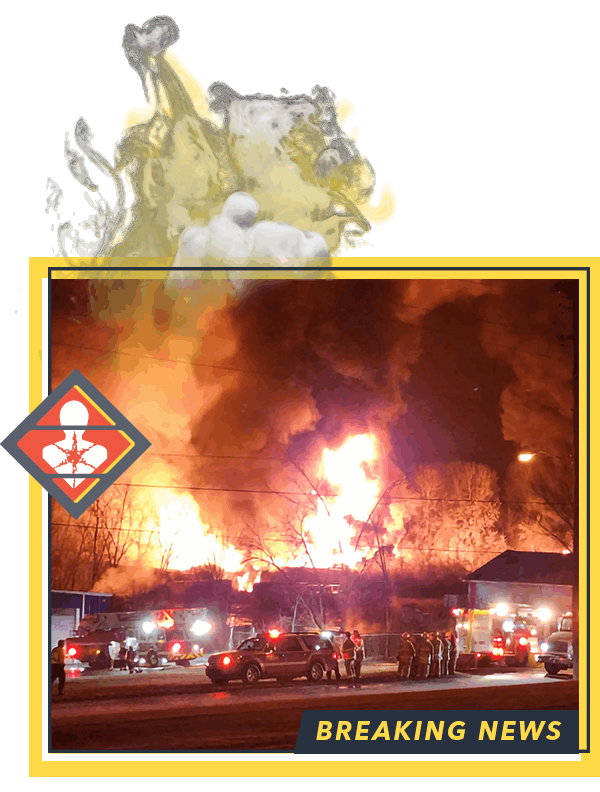
Fire and thick smoke filled the air after hazardous materials ignited following the derailment of a Norfolk Southern train in East Palestine, Ohio.
This devastating derailment was not the first—nor will it be the last—in the United States, a country with a surprising history of train derailments, many of them with toxic and deadly effects on America’s waterways.
According to the U.S. Department of Transportation, rail transportation is the safest way to move hazardous materials across the United States.1 While it may be the safest, there is still room to make it safer and less hazardous to millions of Americans and the environments near railways.
History of Train Derailments in the United States
There are over 1,200 train derailments every year in the United States.2 This equates to about three derailments each day. The vast majority of these are minor incidents with no injuries and little to no damage. However, a small—but significant—number of these derailments have catastrophic effects.
Between 2013 and 2023, there were over 12,500 derailments. Of those:2
- 136 leaked toxic chemicals into the environment
- 161 resulted in injuries to 1,237 people
- 7 killed 23 people
- 70 caused 18,595 people to be evacuated
In recent years, multiple train derailments have involved hazardous chemicals spilling into waterways. One of the most devastating of these was the East Palestine incident. Other derailments include:2
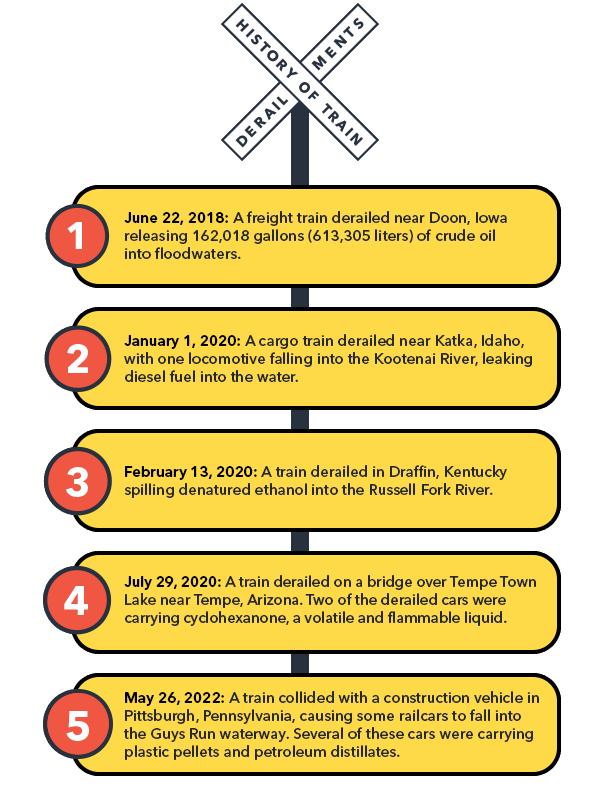
Train Derailments are a frequent occurrence in the United States. This graphic reviews recent incidents that impacted waterways.
Even with the seemingly “good” safety record of rail transport, there is still significant room for improvement, especially when it comes to protecting our environmental resources.
Why Toxic Train Derailments Keep Happening
The shocking aftermath of the derailment in East Palestine—and other significant incidents—can make many wonder why this keeps happening.
Lack of Safety Protocols
According to the National Transportation Safety Board, the cause of the East Palestine derailment may have been an overheated wheel bearing.3 When the crew was finally alerted (after the third increasingly higher temperature reading), they attempted to stop the train—but it was too late.
This series of events raises questions about the reliability and spacing of the safety sensors, called hot-bearing detectors, on the Norfolk Southern tracks. These sensors are typically placed many miles apart alongside the tracks. In addition, Norfolk Southern’s guidelines only require crews to respond once temperature readings are 170 °F (77 °C) above the ambient outdoor temperature.3
Could the sensors be placed closer together, or have the alert temperature set lower?
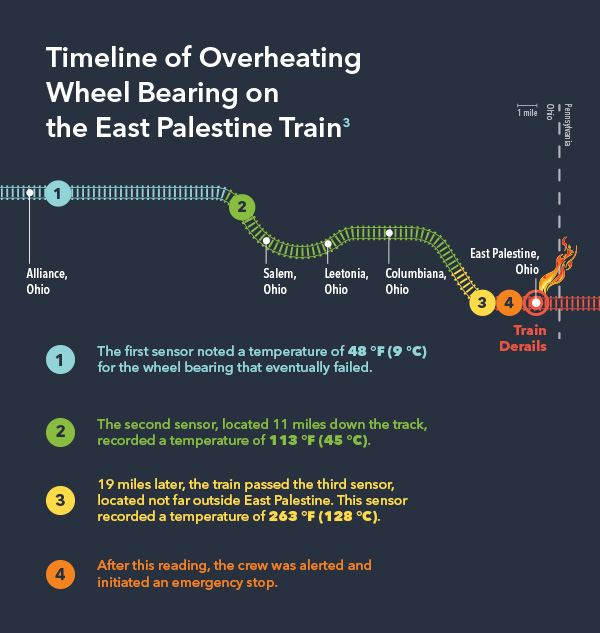
Sensors on the track outside East Palestine, Ohio, suggest that an overheated wheel bearing may have been the cause of the derailment.

Cost-Cutting Measures
Railroad companies have been cutting costs for decades by running longer trains with smaller crews. While these measures may save them money, they come at the expense of safety. According to a report from USA TODAY, in the last five years, federal rail inspectors have reported 36% more hazardous material violations than the five years prior.4
Many rail workers and union representatives say that reports like these and the recent slew of hazardous train derailments point to a dangerous railroad industry doing whatever it takes to save money, no matter the outcome. Workers claim they are allowed insufficient time to properly inspect cars and tracks because of the prioritization of scheduling and efficiency.5
While speaking with USA TODAY, Matthew A. Weaver, a Railroad Workers United union representative, said, “The idea is to do more with less. That’s why we’ve been predicting more and bigger derailments.”5
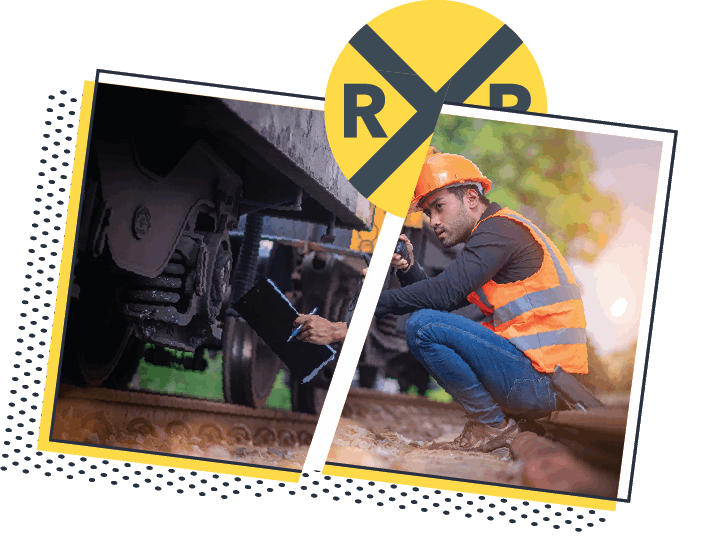
Cost-cutting measures in the railroad industry could be helping to fuel the issue of frequent train derailments in the United States.
Reliance on Toxic Chemicals
Insufficient safety sensors and protocols are just one part of why we keep seeing these toxic accidents. Another significant factor is the materials transported by these trains. The Norfolk Southern train was carrying a large supply of vinyl chloride, a volatile chemical used to make plastics like PVC.
According to documents released by the NTSB, the vinyl chloride eventually incinerated in the East Palestine disaster came from an OxyVinyls chemical plant in La Porte, Texas.6 It was headed to a Pedricktown, New Jersey plant that uses vinyl chloride to make PVC flooring.
Not only does transporting these chemicals by rail pose an increased risk to humans, wildlife, and the environment, the process of turning these chemicals into plastic can release harmful chemicals into the air and water, including benzene, xylene, and toluene. The production process can release tiny microplastics into waterways, causing harm to birds, fish, and other aquatic life.7

The use of PVC is prevalent around the world. However, some localities are making changes. Sweden is phasing out PVC by replacing it with less toxic materials, including plant-based plastic. Similar pushes are being made in Canada, South Korea, Spain, and some U.S. cities and states.8
If the United States successfully switched to less toxic materials, train derailments—while still bad—could be less devastating to our communities and the environment.
Environmental and Health Effects of Toxic Derailments
Many East Palestine residents fear the potential side effects of vinyl chloride exposure. This manufactured toxic gas is known as a carcinogen, and it’s associated with an increased risk of liver, brain, and lung cancers, along with leukemia and lymphoma. The primary risk of exposure comes from inhalation, and thousands of pounds of vinyl chloride were purposefully incinerated on-site.
The contamination is also deadly for wildlife. According to the Ohio Department of Natural Resources, the leaked and ignited vinyl chloride potentially killed more than 43,000 aquatic animals, including fish, crustaceans, and amphibians. Department officials say most of the aquatic life was killed immediately following the incident, and it has not seen any additional signs of suffering or loss of life.9
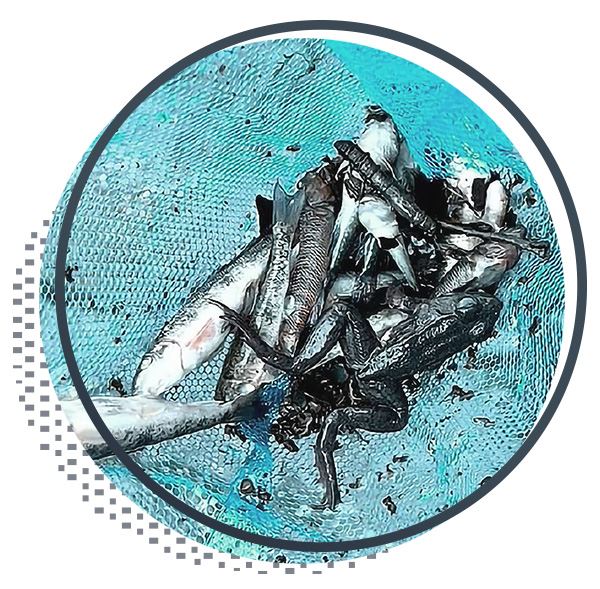
Over 43,000 aquatic organisms were killed when enormous amounts of toxic chemicals were released into the environment after the East Palestine train derailment. Image Source: Logan Rance
The Ohio EPA described the Sulphur Run stream near the derailment site as “grossly contaminated.” While this water is not the source of municipal drinking water for East Palestine—the source is groundwater, not surface water from Sulphur Run—residents with private wells have been encouraged to get their water tested. The Ohio EPA installed several groundwater testing wells to continue monitoring the water quality; samples have not indicated any risk to the public water supply.10
The hydrocarbon contamination within the Sulphur Run bonded with sediments in the water. When disturbed, the sediment releases those hydrocarbons into the water. Since the incident, contractors have been working to remove the contaminated water and sediment.10
Surface water testing in Sulphur Run as of Summer 2023 indicated no detectable presence of benzene and vinyl chloride, with decreasing levels of acrylates and glycols. Water from Sulphur Run eventually empties into the Ohio River, where no contaminants have been detected.10

Groundwater serves as the source of municipal drinking water for East Palestine. Due to the direction of groundwater flow, no groundwater from the derailment site should reach the municipal wellfield. Original Graphic Source: Ohio EPA
Possibilities for Improvement
In a visit to East Palestine after the derailment, Department of Transportation Secretary Pete Buttigieg remarked that stronger safety regulations for railroads could potentially prevent incidents like this.11 Changes such as temperature sensors placed closer together, stronger brakes, improved rail cars, and even higher fines could all help improve rail safety.
With the strong reaction to the East Palestine crash and those that quickly followed, many wonder if the railroad industry will do anything to improve safety protocols. If they don’t take action, the federal government could step in and pass legislation to turn some of these suggested safety improvements into law.

The global community also must look at our extreme reliance on plastics. Many toxic chemicals transported by rail are primarily used in the plastics industry. With reduced plastic consumption, there would be less need to transport these hazardous chemicals across the country, significantly reducing the risk to the health and safety of our communities and the environment.

SOURCES
1 Federal Railroad Administration, Hazardous Materials Transportation
2 Federal Railroad Administration, Ten Year Accident/Incident Overview
3 NTSB, Preliminary Report | Norfolk Southern Railway Train Derailment with Subsequent Hazardous Material Release and Fires
4 USA Today, How often do train wrecks spill hazardous chemicals into neighborhoods? Here’s what data shows
5 USA Today, Longer trains, fewer workers: Minnesota derailment follows years of railroad cost cutting
6 NTSB, Project Summary: Rail Public Hearing
7 Center for Biological Diversity, The Plastic-Production Problem
8 CHEJ, PVC Policies Across the World
9 Ohio Department of Natural Resources, ODNR Update on East Palestine Train Derailment Impact to Wildlife
10 Ohio EPA, East Palestine Train Derailment Information
11 NPR, Buttigieg calls for stronger railroad safety rules after East Palestine disaster